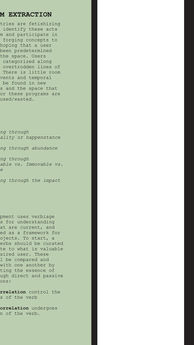Archivelopment
speculative design
Buildings are bored; they are controlled by programmatic schemes and designed not to respond to users but instead house them under typical configurations. In its process, alternative interaction will provide an architecture that sufficiently becomes responsive to resolutions, becoming a hub of natural experience and providing re-imagined value to the user. Through an activity-based defining procedure, we can solicit awareness in users of space and the human condition that occupies the space and uncover new hidden devices.
By rejecting the focus on vanity and praise from the beginning, a reorientation can manifest for how architects/developers base their practices. The perceptual approach of photorealistic images embodies a false narrative that promises an adequate place for making. However, investigating these environments through objects and activity can be a basis for speculating on the possibility of interactive architecture. This argument focuses highly on objects and activities as identifiers for human ability and discourse. This investigation could have far-reaching effects on architecture. However, these fields may have yet to be understood or developed as a direct response to previously identified architectural demands. Instead, they have risen due to the availability of new technology and mass consumerism. With its practical conceptualization and realistic context, can architectural development promise valuable spaces for the future? Or do we need to reexamine our built environment not as a deployment to mimic or influence interaction through a program but rather use air as its medium to engage with events directly?












